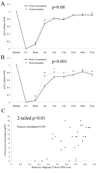Improving neurological outcomes post-cardiac arrest in a rat model: immediate hypothermia and quantitative EEG monitoring
- PMID: 17936492
- PMCID: PMC2323440
- DOI: 10.1016/j.resuscitation.2007.08.014
Improving neurological outcomes post-cardiac arrest in a rat model: immediate hypothermia and quantitative EEG monitoring
Abstract
Objectives: Therapeutic hypothermia (TH) after cardiac arrest (CA) improves outcomes in a fraction of patients. To enhance the administration of TH, we studied brain electrophysiological monitoring in determining the benefit of early initiation of TH compared to conventional administration in a rat model.
Methods: Using an asphyxial CA model, we compared the benefit of immediate hypothermia (IH, T=33 degrees C, immediately post-resuscitation, maintained 6h) to conventional hypothermia (CH, T=33 degrees C, starting 1h post-resuscitation, maintained 12h) via surface cooling. We tracked quantitative EEG using relative entropy (qEEG) with outcome verification by serial Neurological Deficit Score (NDS) and quantitative brain histopathological damage scoring (HDS). Thirty-two rats were divided into 4 groups based on CH/IH and 7/9-min duration of asphyxial CA. Four sham rats were included for evaluation of the effect of hypothermia on qEEG.
Results: The 72-h NDS of the IH group was significantly better than the CH group for both 7-min (74/63; median, IH/CH, p<0.001) and 9-min (54/47, p=0.022) groups. qEEG showed greater recovery with IH (p<0.001) and significantly less neuronal cortical injury by HDS (IH: 18.9+/-2.5% versus CH: 33.2+/-4.4%, p=0.006). The 1-h post-resuscitation qEEG correlated well with 72-h NDS (p<0.05) and 72-h behavioral subgroup of NDS (p<0.01). No differences in qEEG were noted in the sham group.
Conclusions: Immediate but shorter hypothermia compared to CH leads to better functional outcome in rats after 7- and 9-min CA. The beneficial effect of IH was readily detected by neuro-electrophysiological monitoring and histological changes supported the value of this observation.
Conflict of interest statement
Figures





References
-
- Jia X, Koenig MA, Shin HC, Zhen G, Geocadin RG, Thakor NV. Detection and Monitoring of Brain Recovery after Therapeutic Hypothermia in a Post-cardiac Arrest Rodent Model: A Quantitative EEG Study. Circulation Research. 2006;99:E45P156.
-
- Shin H-C, Jia X, Thakor NV. Neuroscience 2006, the Society's 36th annual meeting. Atlanta, USA: Georgia; 2006. Effects of ischemic brain injury on thalamo-cortical and cortico-thalamic interaction: neural electrical perspectives.
-
- Shin H-C, Jia X, Thakor NV. World Congress on medical physics and biomedical engineering 2006. Seoul, Korea: 2006. Quantitative Analysis of Neural Electrical Activities in Thalamus and Cortex after Ischemic Brain Injury.
Publication types
MeSH terms
Grants and funding
LinkOut - more resources
Full Text Sources
Other Literature Sources

